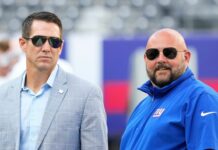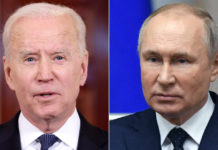SOUTHAMPTON, N.Y. — On the eve of the 118th United States Open, Tiger Woods was hitting bunker shots in the short-game practice area when Rory McIlroy entered his peripheral vision. Woods stopped and wished McIlroy well. Then he extended his hand for McIlroy to shake, and mischievously pulled him into the bunker.
When the Open’s first round began on Thursday at Shinnecock Hills Golf Club, Woods had to grind to avoid being yanked into the same abyss that swallowed McIlroy, who posted a 10-over 80 in the morning.
Teeing off several minutes after McIlroy signed his scorecard, Woods played the first nine in three over, no small feat given that he had tripled the opening hole after finding the fairway with his tee shot.
Down the stretch, Woods’s round frayed like a kite tail in Shinnecock’s 20-mile-an-hour gusts. At the par-4 13th, he four-putted on his way to a 78.
Woods has not won a tournament since 2013 or a major in 10 years. It is immaterial. Wherever he has gone this week, he has been a magnet — for hordes of fans, fellow players, even a member of the World Golf Hall of Fame bearing advice on his putting, which has become a problem lately.
Amy Alcott, the Hall of Famer who won 29 events on the L.P.G.A. Tour, saw Woods’s caddie, Joe LaCava, in the players’ parking lot on Wednesday and approached him with the tip. LaCava promised to pass it on to Woods.
But Thursday brought more of the same troubles. Woods took 30 strokes with his flat stick. “I just didn’t putt very well,” he said after finishing nine strokes behind the four leaders, a group that included a player in his threesome, Dustin Johnson.
Still, Woods can expect deep galleries again on Friday. No doubt, fans follow along to see if he can be a major contender again, after four back surgeries since 2014. But they come in appreciation, too, for the athlete who has won 79 PGA Tour events, including 14 majors, and who almost slipped away from the sport — missing the last two U.S. Opens because of his damaged spine.
His competitors understand the sentiment. When Woods stepped on the practice range during a light rain Wednesday afternoon, he was stopped by two young players. One asked if he could have a photograph taken with Woods, and the other shook his hand vigorously as he introduced himself.
The player who ended up with the photograph was Scott Gregory, 23, a second-year pro from England who opened on Thursday with a birdie-free 92, the highest score at a United States Open since 2002. After his round, Gregory spent several minutes amiably answering reporters’ questions.
Sure, the round was disappointing, he said, but he knows he is a better golfer than that. Otherwise, how would he have qualified for the tournament?
Besides, he will always have his photograph with Woods. “I’ve been waiting for that picture for about 15 years, so that was a pretty big deal,” Gregory said. He already had the photograph framed and displayed in his locker.
“It’s weird, you can feel when he is about,” Gregory said. “If you’re on the putting green and you haven’t seen him, you can still hear that he’s around.”
Jason Day, a former world No. 1, referred to that phenomenon as “the Tiger effect.” On Tuesday, Day said, he was practicing putting in near solitude when Woods showed up. Within seconds, Day said, the practice green filled with players.
“Everyone wants to see him,” Day said. “Everyone wants to see what he looks like and how big is he or just kind of see, I guess, the myth.”
Woods won the most recent of his three United States Open titles in 2008, while hobbled by a shredded left knee and a fractured left leg. His most formidable adversary that week was not Rocco Mediate, the runner-up who extended Woods to 19 extra holes (an 18-hole playoff and one in sudden death). It was the physical pain from his injuries, which Woods did not disclose until after his win.
“You never want to let any of the guys know you’re hurt in any sport, doesn’t matter, ever,” he said in 2013 on the five-year anniversary of the victory.
Those were the days when Woods was an executioner in exercise clothing. He could shatter an opponent’s confidence with his stare, and he gave away few strokes and fewer secrets. But then came the public revelations of marital infidelities in November 2009, leading to the dissolution of his marriage, and the back surgeries followed, leading to the disintegration of his game.
Since rejoining the Tour in January, after his latest operation, Woods has shown flashes of his old game — and a new openness. The glares are gone, replaced by gratitude and a good-natured attitude that Day perhaps tested earlier this week.
He said he teased Woods in a text about the “M.C. Hammer” parachute pants, as Day described them, that Woods wore the last time the national championship was held here, in 2004.
“And he didn’t text me back,” said Day, who can usually count on a reply from Woods. “You can see his killer instinct is kind of starting to go more toward what it used to be,” Day added, “but he’s not as aggressive with regards to that.”
Woods seems more willing to turn the dagger on himself. By the time he hit his opening shot Thursday, six players were under par (four players finished under 70) and several more had posted scores of over 79. As he watched the early action from his yacht, Privacy, Woods revised his game plan.
Instead of focusing on the holes where he thought he could chase birdies — because the wind swept away those prospects — Woods said his aim was to avoid any scores over bogey.
“And then I made three of them,” he said, alluding to consecutive doubles on the back nine and an opening triple.
And then he laughed.
Woods used to be the game’s best front-runner, but this year he has struggled in his first rounds even in favorable conditions, averaging 71.11 strokes in the first round and 70.63 in the fourth.
On a day when Shinnecock Hills turned into a grinder’s paradise, Woods, the prince of perseverance, faltered. And lived to laugh about it.
“He seems on a mission to repair his body, his game and his image,” the Golf Channel analyst Brandel Chamblee said. “Perhaps it’s because his kids are old enough to Google their father or perhaps when he was at his lowest point he found the value in friends and they got through to him.”
Source : NYtimes













